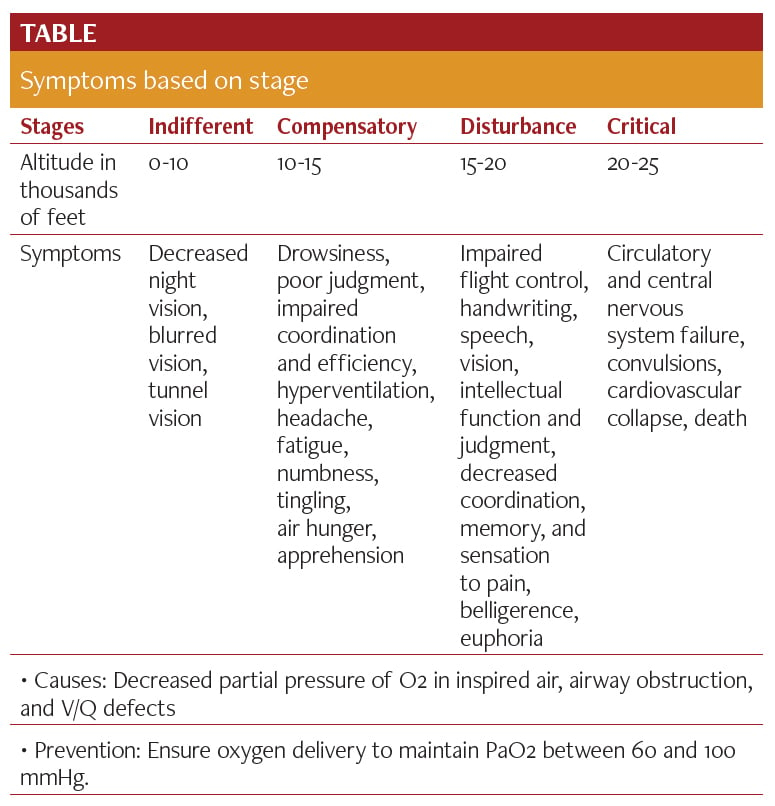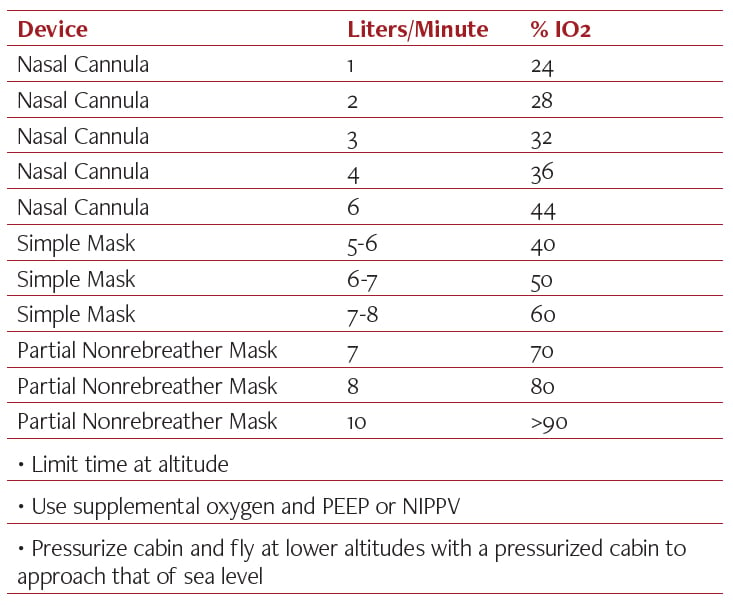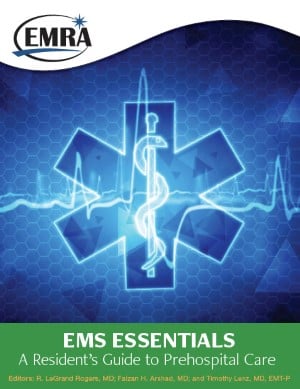Ch 12. Subspecialty: Flight
Transporting patients via air has become a way of doing busi- ness, especially to tertiary referral centers from rural medical centers. This resource has great utility in critical times. Yet it also presents numerous challenges, thanks to basic laws of physics.
In alleviating the dangers associated with air transport, it is im- perative that all EMS providers associated with transport as well as physicians at the receiving center have a basic understanding of this physiology.
Boyle’s Law: Gases expand with increasing altitude as baro- metric pressure decreases. The inverse applies on the descent.
Transport considerations: Altitude becomes an important consideration in an unpressurized aircraft, such as a helicopter. At altitudes where most helicopters fly, gas expansion is roughly 10-15%. In mountainous regions where helicopters may fly up to 8000 feet above sea level, gas expansion may be 30%. This may affect IV flow rates, ET cuff expansion, and body cavities such as the intestines, middle ear, sinuses, and fascial compartments.
Dalton’s Law: As altitude increases, gases expand and the available oxygen decreases.
At 10,000 feet, atmospheric pressure is 525 mmHg compared to 760 mmHg at sea level, while FiO2 remains 21%. However, the partial pressure of oxygen has decreased to 110 mmHg. This becomes important as a pressure differential is required to cross from the alveoli into the bloodstream.
Medical consideration: This affects oxygen delivery to the body. Newborns and neonates are more likely to develop hypoxia, as a newborn’s alveolar-arterial difference is roughly 25 mmHg com- pared to 10 mmHg in adults. As altitude increases, oxygen delivery decreases.
Transport considerations: As altitude increases and pressure decreases, gas expansion causes available oxygen to decrease. Therefore, someone with an SpO2 of 92% at sea level may de- saturate to 80% at altitude, even in a cabin pressurized to 12,000 feet.
Henry’s Law: This pertains to solubility of gases within a liq- uid.
The partial pressure of gases and the solubility of the gas de- termine the amount of gas that will dissolve into liquid. Decreas- ing pressures at higher altitudes allows for gases to come out of solution, such as blood, into tissues.
Medical considerations: Decompression sickness or the bends and decreasing oxygenation at altitude. Trapped gas in tissue being released or evolved gas in blood being released. The most common joints affected are the shoulders and elbows in recreational divers. In technical divers and aviators, the hips and knees are most affected.
The chokes are caused by gas embolization, mimic a PE, and can lead to cardiovascular collapse. Subcutaneous emphysema is another decompression sickness.
Transport considerations: Unless a patient has been exposed to compressed gas within 24 hours, such as SCUBA diving, trans- port is rarely a problem under 25,000 feet. If a diver requires transport, stay below 8,000 feet, as this is equivalent to a
non-diver flying above 40,000 feet in an unpressurized aircraft. Treatment for all patients is 100% oxygen and rapid descent.
Charles’ Law: At constant pressure, the volume of gases is proportional. As temperature rises, molecules move faster and volume increases.
Medical considerations: Hypoxia and compartment syndrome
Transport considerations: Flight during the winter or middle of summer affects expanding and contracting structures, which rely on the rigidity of the structure containing the gas.
Real Stresses of Flight and Transport
The most common and worrisome problem in air medical transport is hypoxia, which can go undetected. There are four physiologic classifications of hypoxia.
Hypoxic Hypoxia (Altitude): Stages include indifferent (90- 98% SpO2), compensatory (80-89%), disturbance (70-79%), and critical (60-69%). This results in inadequate gas exchange at the alveolar-capillary membrane. Without compensatory mecha- nisms, this is usually encountered above 10,000 feet.
Oxygen Adjustment Equation: (FiO2 x BP1) / BP2 = FiO2 required
BP1 = current barometric pressure
BP2 = altitude or destination barometric pressure


Barometric Stress: Trapped gas (Boyle’s Law) and evolved gas (Henry’s Law) disorders. Free gas in body cavities expands, and if it cannot escape, positive pressure develops barotrauma.
Organ systems affected
GI tract: At constant temperature and altitude, the volume of wet gas is greater than dry gas due to water vapor. 1L of wet gas in the stomach and intestines may rapidly expand and cause severe pain, tachycardia, hypotension, syncope, and interfere with breathing. Expel gas by whatever means necessary via NG/OG.
- Respiratory: Pneumothorax increasing to tension pneumothorax. Unclamp catheters and chest tubes, perform thoracentesis, and descend to lower altitude.
- Barobariatrauma: Complication of barometric changes in obesity. Adipose tissue contains a high concentration of nitrogen that may be released into the blood stream, as well as a large amount of lipids that may cause fat emboli. Observe these patients for severe dyspnea, chest pain, petechia, pallor, and tachycardia. Placing an obese patient on 100% oxygen for pre-oxygenation prior to transport will help reduce the risk of barotraumas by roughly 50%.
- Barotitis media: Middle ear squeeze as equalization occurs may cause pain, vertigo, nausea, ear drum perforation, bleeding, or hearing loss. Equalization occurs by slow descent (500 feet/minute), yawning, swallowing, valsalva, Frenzel maneuver, or vasoconstricting nasal spray. Barosinusitis and barodentalgia are similar in physiology and treatment.
- Pregnancy: Because fetal hemoglobin is more saturated at lower PaO2, fetal considerations for transport are less of a concern and maternal care and oxygenation should be the primary goal, as they may decompensate much faster at higher altitudes.
Thermal Stress: Thermal stress is the body’s physiologic re- sponse to its environment, as the body is either dissipating heat to its environment to cool itself or creating heat by using energy. In all cases, the body is exchanging energy. The major concern of thermal stress is causing hypothermia and coagulopathy in patients moving toward the, “Lethal Triad,” defined as hypother- mia, acidosis, and coagulopathy. Factors contributing are ambi- ent temperature, exposure time, cabin air circulation, litter posi- tion, and hot loading/unloading.
Cold physiologic effects include shivering, vasoconstriction, increased metabolic rate, myoclonic tensing, hypothermia, and coagulopathy.
G-Forces: Gravitational forces are acted on the patient during ascent, descent, and banking which may affect blood pooling and cause stagnant hypoxia. Positive “Gs” will move blood from the head toward the feet causing increased intravascular pres- sures, hypoxia, G-LOC (G force induced loss of consciousness), and blackouts. Negative “Gs” will cause blood pressure to rise in the head causing “redout,” headaches, and increasing ICP.
Noise: Provide your patient and yourself with hearing protec- tion as even non-hazardous noise may become hazardous with prolonged exposure. Hazardous noise may cause fatigue and headache. Noise also inhibits your ability as a care provider to properly monitor the patient.
Vibration: Little can be done to decrease vibration in trans- port, but precaution should be taken. Vibrations may interfere with patient assessment, invasive and noninvasive monitoring, and pacemakers. Effects include motion sickness, blurred vision, increasing heart and respiratory rates, metabolic rates, pain, irri- tability, fatigue, and thermal regulation. In a hypothermic patient, vibration may worsen the patient’s condition. In a hyperther-
mic patient, vibration may cause vasoconstriction, delaying the body’s ability to cool itself. Ensure the patient and crew is prop- erly restrained and place padding on any part of the frame that may contact the patient to combat effects of vibration.
Third-spacing: This is primarily an effect seen during long distance transports where decreasing barometric pressure may cause leakage of fluid from intravascular spaces. This is further aggravated by temperature changes, vibration, and G-forces.
Humidity deficit: Water vapor in the air decreases as alti- tude increases. After 2 hours of flight, less than 5% of relative humidity remains in air circulation. Physiologic effects include respiratory membrane inflammation, decreased efficiency of gas exchange, desiccation, hypoxia, increasing BMR, and oxygen demand. Monitor high-risk patients such as burn, ventilator, and pre-existing dehydration patients closely. Maintain fluid replace- ment and humidified oxygen as needed.
References
- Blumen IJ, et al. Principles and Direction of Air Medical Transport. Air Medical Physician Association. 2006.
- Aeromedical Training For Flight Personnel: Altitude Physiology. Training Circular. Department of the Army. 2000.
- Critical Care in the Air. U.S. Air Force Critical Care Air Transport Team.
- Aeromedical Training. FM 3-04-301. U.S. Air Force Critical Care Air Transport Team Training Document.
- Capt John Michael Fowler. Flight Physiology. CCAT instructor.





